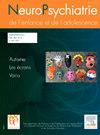Prévalence des diagnostics d’autisme via le système national de données de santé. Analyse rétrospective de cohorte sur la période 2010–2022
Q4 Medicine
Neuropsychiatrie de l''Enfance et de l''Adolescence
Pub Date : 2025-09-01
DOI:10.1016/j.neurenf.2025.01.006
引用次数: 0
Abstract
Objective
Autism is considered a major public health issue in France and internationally. In contrast to other countries, where multiple epidemiological studies have been carried out for many years, scientific data on the prevalence of autism in France remains scarce. This article aims to provide reliable figures by way of the National Health Data System (SNDS) and to update the currently available epidemiological studies.
Method and results
The prevalence of autism via the SNDS was 0.1% in 2010, rising to 0.2% in 2022. It was four times higher among males than females. The prevalence of autism via the SNDS was significantly higher in children and decreased with age. Among children aged 8, it doubled between 2010 and 2022, rising from 0.45 to 0.94%. More specifically, this prevalence of autism via the SNDS rose from 0.7 to 1.5% for 8-year-old boys and from 0.2 to 0.4% for girls. Among children aged 0 to 10, the diagnosis peak was at age 3, with a steep rise between ages 1 and 3. Between 2010 and 2022, the proportion of autistic patients aged 0 to 17 living in unfavorable social conditions rose from 29 to 42.4%.
Conclusion
Estimating the prevalence of autism is essential for informing public authorities and adapting the needs of care, education and social intervention services. Epidemiological research on autism and the data contained in the SNDS contribute to this effort aimed at assisting patients and their families.
通过国家卫生数据系统诊断自闭症的流行率。2010 - 2022年回顾性队列分析
目的自闭症在法国和国际上被认为是一个重大的公共卫生问题。与其他国家多年来开展了多项流行病学研究相比,法国自闭症患病率的科学数据仍然很少。本文旨在通过国家卫生数据系统(SNDS)提供可靠的数据,并更新现有的流行病学研究。方法与结果2010年通过SNDS的自闭症患病率为0.1%,2022年上升至0.2%。男性的自杀率是女性的四倍。通过SNDS的自闭症患病率在儿童中明显较高,并随着年龄的增长而下降。在8岁儿童中,这一比例在2010年至2022年间翻了一番,从0.45%上升到0.94%。更具体地说,通过SNDS的自闭症患病率在8岁男孩中从0.7上升到1.5%,在女孩中从0.2上升到0.4%。在0 - 10岁的儿童中,诊断高峰在3岁,在1 - 3岁之间急剧上升。2010年至2022年间,0 - 17岁自闭症患者生活在不利社会环境中的比例从29%上升到42.4%。结论评估自闭症的患病率对于告知公共当局和适应护理、教育和社会干预服务的需求至关重要。关于自闭症的流行病学研究和SNDS中所载的数据有助于这项旨在帮助患者及其家属的努力。
本文章由计算机程序翻译,如有差异,请以英文原文为准。
求助全文
约1分钟内获得全文
求助全文
来源期刊

Neuropsychiatrie de l''Enfance et de l''Adolescence
Medicine-Pediatrics, Perinatology and Child Health
CiteScore
0.60
自引率
0.00%
发文量
61
期刊介绍:
Organ of the Société française de psychiatrie de enfant et de adolescent, Neuropsychiatrie de enfance et de adolescence tackles all fields of child-adolescent psychiatry and offers a link between field and clinical work. As a reference and training tool for students and practitioners, the journal publishes original papers in child psychiatry as well as book reviews and conference reports. Each issue also offers a calendar of the main events dealing with the speciality.
 求助内容:
求助内容: 应助结果提醒方式:
应助结果提醒方式:


